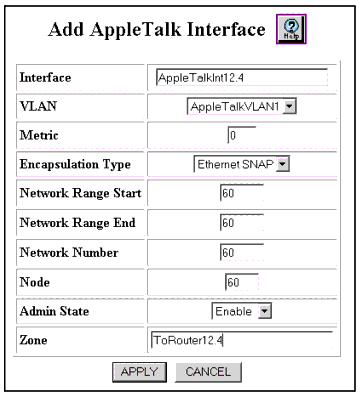|
|
|
To create an AppleTalk routing interface using the Web Agent:
The AppleTalk Interfaces Web page is displayed in the content pane. See Figure�187.
Figure�187:�AppleTalk Interfaces Web Page

Figure�188:�Add AppleTalk Interfaces Web Page

| Parameter |
Description |
|---|---|
| Interface |
Enter the name of the AppleTalk interface to be created. 1 to 32 Characters |
| VLAN |
Select the VLAN to be associated with the AppleTalk interface. |
| Metric |
Enter the metric associated with the AppleTalk interface. |
| Encapsulation Type |
Select the encapsulation type to be associated with the AppleTalk interface.The options include:
|
| Network Range Start |
Enter the starting network number. The network number specifies the range of AppleTalk network numbers for extended networks. Each number in the range must be an integer between 0 and 65279. Note: The Network Range Start value must be less than or equal to the Network Range End value. |
| Network Range End |
Enter the ending network number. The network number specifies the range of AppleTalk network numbers for extended networks. Each number in the range must be an integer between 0 and 65279. Note: If the Network Range Start value equals 0, then the Network Range End value must also equal 0. |
| Network Number |
Enter the interface network number. This number specifies the network number the interface is using. Note: This value must be within the Network Range or be equal to 0. |
| Node |
Enter the interface node identification number. This number must be between 1 and 253. Note: Only if the Network Number is equal to 0, can the Node also be equal to 0. |
| Admin State |
Select whether to enable or disable the administrator state. The administrator state determines if the interface is operational from a management point of view. |
| Zone |
Select the default AppleTalk zone to be used by this interface. Zone names may be up to 32 characters in length. |
Figure�189:�AppleTalk Interfaces

|
|
|